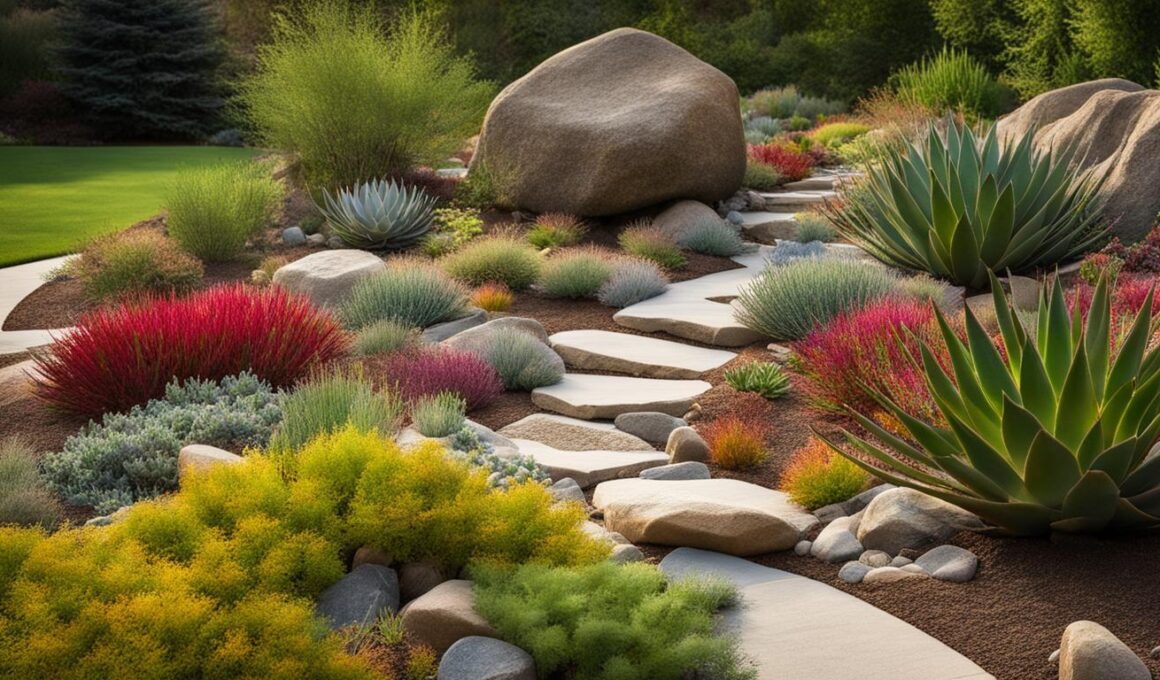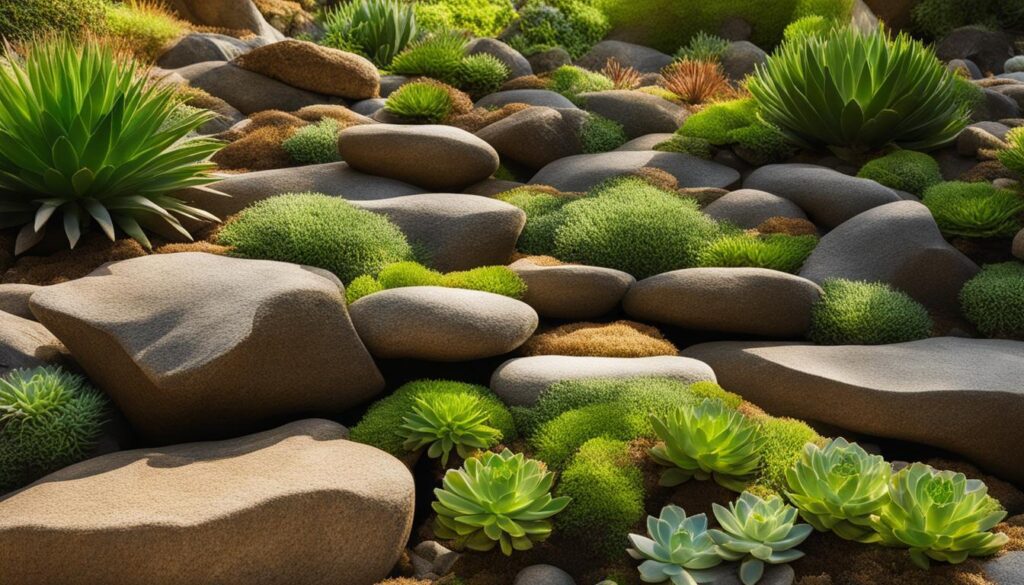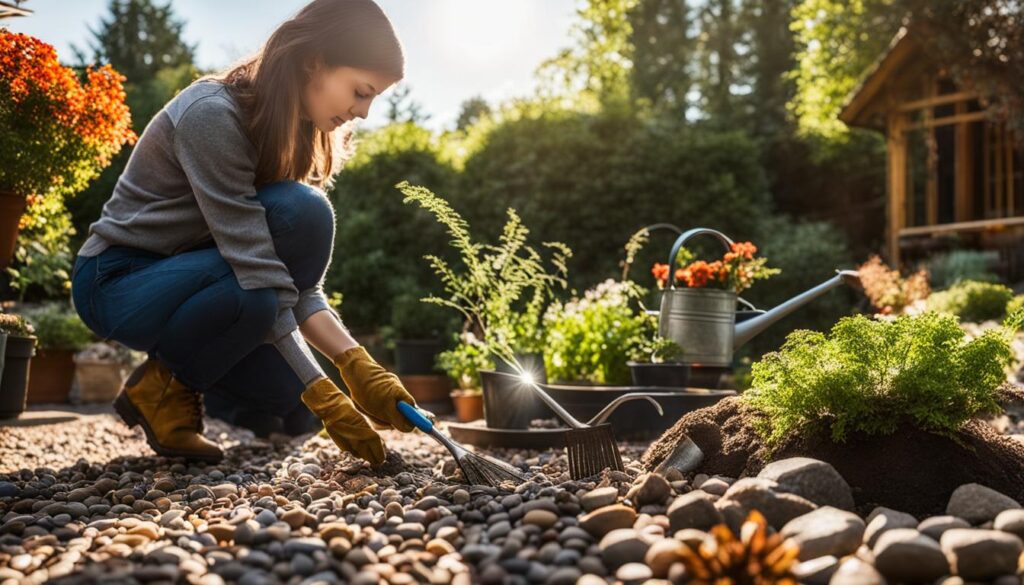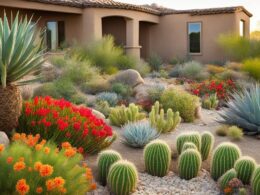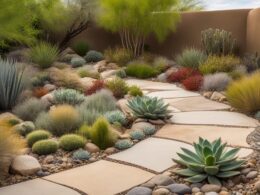Creating a beautiful and eco-friendly garden doesn’t have to be a water-consuming endeavor. With a xeriscape rock garden, you can conserve water while enjoying a stunning landscape right in your backyard. In this article, we will guide you through the process of building your own xeriscape rock garden, from designing the layout to selecting the right plants and materials. Discover how to create an oasis that not only saves water but also enhances the aesthetic appeal of your outdoor space.
Key Takeaways:
- A xeriscape rock garden is an eco-friendly garden that requires minimal water usage.
- By incorporating drought-resistant plants and rocks into your design, you can create a stunning landscape that conserves water.
- Designing your rock garden involves considering the shape, size, and location, as well as selecting rocks and planning a color scheme.
- The key materials and tools for building a rock garden include rocks, gravel, soil, plants, and common gardening tools.
- Follow a step-by-step guide to properly build and maintain your xeriscape rock garden for long-term success.
What is a Rock Garden?
A rock garden, also known as an alpine garden or rockery, is a landscape feature designed to showcase rocks, boulders, and stones. It is laid out in unique designs that include drought-resistant plants and various decorative elements like pavers, sculptures, and fountains. Rock gardens can be built in raised or sprawling designs, depending on the available space and desired aesthetic. They can also be tailored to different styles, such as xeriscapes, Japanese rock gardens, water gardens, or native plant gardens.
Creating a rock garden allows you to incorporate nature’s timeless beauty into your landscape. The combination of rocks and plants creates a visually stunning and harmonious space that can be enjoyed throughout the year. Additionally, rock gardens are known for their low-maintenance nature, making them an attractive option for homeowners who want a beautiful garden without spending excessive time and effort on upkeep.
Rock gardens can be customized to suit your personal style and preferences. Whether you prefer a minimalist design with simple lines and a limited color palette or a more elaborate arrangement with a diverse range of plants and rock formations, the options are endless. The versatility of rock gardens makes them a popular choice for both small urban spaces and larger suburban yards.
Key Features of a Rock Garden
- Incorporation of rocks and stones as the main focal point
- Use of drought-resistant plants that can thrive in rocky conditions
- Strategic placement of rocks to create visual interest and define different areas
- Inclusion of pathways, sculptures, and water features to enhance the overall design
- Opportunity to incorporate native plants and support local ecosystems
Rock gardens are a popular choice for those seeking a low-maintenance yet visually appealing garden. With their unique blend of natural elements, rock gardens offer a tranquil and serene environment that can be enjoyed for years to come.
Designing your Rock Garden
Designing your rock garden is an exciting process that allows you to create a unique and visually appealing outdoor space. Consider the shape, size, and location of your garden area before starting your design. Use a garden hose to experiment with different shapes and sizes, allowing you to visualize how the final layout will look.
Another important aspect of rock garden design is choosing the right color scheme. Select plants and rocks that complement each other to create a harmonious and cohesive look. For example, pairing vibrant green plants with gray or brown rocks can create a natural and balanced aesthetic. Additionally, consider incorporating rocks of different sizes and shapes to add visual interest and texture to your garden.
Before you start placing rocks and plants, it’s essential to prepare the soil properly. Ensure your soil has good drainage by adding compost and sand if needed. Well-draining soil will prevent waterlogging and help your plants thrive in the rock garden environment. Taking the time to plan out your design, choose a suitable color scheme, and prepare the soil will set the foundation for a successful rock garden.
Materials and Tools for Building a Rock Garden
Building a rock garden requires specific materials and tools to ensure its successful construction. By gathering the necessary supplies beforehand, you can streamline the process and create a beautiful and functional rock garden. Here are the key materials and tools you will need:
Rocks
- Choose a variety of rocks, such as boulders, stones, or pebbles, to add visual interest to your rock garden.
- Select rocks of different sizes and shapes to create texture and depth in your design.
- Consider using rocks native to your area to maintain a natural look and reduce costs.
Gravel
- Pea gravel and crushed granite are popular options for filling in between plants and creating pathways in your rock garden.
- Choose a gravel color that complements the overall color scheme of your garden.
- Ensure the gravel you select is appropriate for your specific climate and drainage needs.
Soil
- Prepare your soil by removing any existing vegetation and ensuring proper drainage.
- Amend the soil with organic matter, such as compost, to improve its fertility and moisture-retaining properties.
- Consider using a well-draining soil mix designed for succulents and drought-tolerant plants.
Plants
- Choose drought-tolerant and native plants that thrive in your local climate and soil conditions.
- Consider the sun exposure and water requirements of each plant when arranging them in your rock garden.
- Include a variety of foliage colors, textures, and heights to create visual interest.
Tools
- Common gardening tools such as a trowel, shovel, rake, and wheelbarrow will be necessary for the installation process.
- Use a measuring tape or ruler to ensure accurate placement and spacing of rocks and plants.
- Consider using landscaping fabric or weed barrier to suppress weed growth in your rock garden.
By having these materials and tools on hand, you’ll be well-prepared to begin building your rock garden. Remember to follow the design plan you outlined in Section 3 and take your time to create a visually appealing and functional outdoor space.
Step-by-Step Guide to Building a Rock Garden
Planning and designing your rock garden is an exciting process that allows you to create a unique and visually appealing outdoor space. Follow these steps to successfully build your own xeriscape rock garden:
1. Planning your design
Before getting started, take some time to plan the design of your rock garden. Consider the shape, size, and location of your garden area. Experiment with different shapes and sizes using a garden hose to visualize the layout. Think about how you want to incorporate rocks, plants, and other elements into your design to create a harmonious and balanced aesthetic.
2. Site preparation
Prepare the site for your rock garden by clearing the area of any existing growth. Remove weeds, grass, and other vegetation to create a clean canvas. It’s also important to ensure good drainage for your rock garden. If necessary, amend the soil by adding compost and sand to improve its drainage capabilities.
3. Creating layers
To create depth and visual interest in your rock garden, it’s essential to create layers. Start by adding a layer of small rocks or pebbles as the base. This layer will aid in drainage and prevent soil erosion. Next, add a layer of sand to create a stable foundation for the rocks. Finally, add a layer of nutrient-rich soil for your plants to thrive.
4. Positioning rocks
Positioning rocks strategically is key to achieving a natural and visually appealing rock garden. Use larger rocks as focal points or to define planting areas. Place them in a way that mimics the natural formation of rocks found in nature. Experiment with different arrangements to find the perfect positioning for your rocks.
5. Planting
Once your rocks are in place, it’s time to plant your chosen drought-tolerant and native plants. Consider the sunlight and water requirements of each plant and place them accordingly in your rock garden. Group plants with similar needs together to simplify maintenance and create visual cohesion. Add mulch around the base of plants to conserve moisture and suppress weed growth.
Now that you have a step-by-step guide to building a rock garden, you’re ready to embark on your landscaping journey. The process may take time and effort, but the end result will be a stunning xeriscape rock garden that brings beauty and sustainability to your outdoor space.
What are the Essential Elements for Building a Xeriscape Rock Garden?
To start a xeriscape garden from scratch, you’ll need essential elements for a rock garden. First, choose drought-tolerant plants like succulents and cacti. Use rocks and gravel for drainage and texture. Ensure proper irrigation system and mulch to retain moisture. Lastly, plan the layout and design for a low-maintenance oasis.
Maintaining Your Rock Garden
Once you’ve built your beautiful xeriscape rock garden, it’s important to maintain it properly to ensure its long-term success. By following a few key maintenance practices, you can keep your garden looking lush and vibrant while minimizing the time and effort required.
Watering
Watering is a crucial aspect of rock garden maintenance, as it directly affects the health of your plants. It’s important to water your plants according to their specific needs, considering factors such as their drought tolerance and the amount of moisture retained by the rocks. Monitor the soil moisture levels and water when necessary, avoiding overwatering as it can lead to root rot and other issues. A drip irrigation system or a soaker hose can be beneficial for delivering water directly to the plants’ roots, minimizing water wastage.
Mulching
Mulching your rock garden offers several benefits, including insulation for plants, weed suppression, and erosion prevention. Apply a layer of organic mulch, such as wood chips or straw, around your plants to help retain moisture, regulate soil temperature, and prevent weed growth. Mulch also adds an aesthetic appeal to your garden, creating a cohesive and polished look.
Fertilizing, Pruning, and Weed Control
Fertilizing your plants is important for providing them with essential nutrients for growth and blooming. Use a slow-release or organic fertilizer specifically formulated for drought-tolerant plants, following the instructions on the packaging. Prune your plants regularly to remove dead growth, promote new growth, and maintain their shape. This also helps improve air circulation and reduces the risk of disease. Additionally, be diligent in controlling weeds by hand-pulling them or using organic weed control methods. Weeds can compete with your plants for resources, so it’s important to keep them in check.
By following these maintenance practices, you can enjoy the beauty and tranquility of your xeriscape rock garden with minimal effort. Remember that each garden is unique, and it’s important to observe and adjust your maintenance routine based on the specific needs of your plants and the local climate conditions. With proper care, your rock garden will thrive and continue to be a source of joy and admiration.
Conclusion
Building a xeriscape rock garden offers numerous benefits for your outdoor space. Not only does it help you conserve water, but it also creates a stunning and eco-friendly landscape that requires minimal maintenance. By following the steps outlined in this guide and incorporating drought-resistant plants and rocks, you can enjoy a low-maintenance oasis in your own backyard.
A xeriscape rock garden is a perfect solution for those looking to reduce their water consumption and create a beautiful outdoor space. With its water-saving features, you can save on irrigation costs and contribute to a more sustainable environment. Plus, the use of rocks and drought-resistant plants ensures that your garden remains vibrant and lush, even in dry conditions.
In addition to the environmental benefits, a xeriscape rock garden offers you the convenience of low-maintenance landscaping. By selecting plants that thrive in well-drained soil and require minimal watering, you can spend less time on upkeep and more time enjoying your garden. Say goodbye to constant mowing and weeding, and say hello to a picturesque and hassle-free outdoor retreat.
Embrace the beauty and practicality of a xeriscape rock garden. With its water-saving features, low-maintenance requirements, and eco-friendly approach to gardening, it is the perfect choice for any outdoor enthusiast. Create a landscape that not only adds value to your property but also contributes to a more sustainable future. Your xeriscape rock garden will be a source of pride and enjoyment for years to come.





